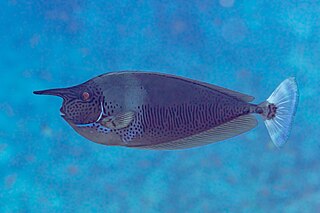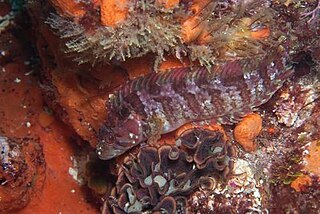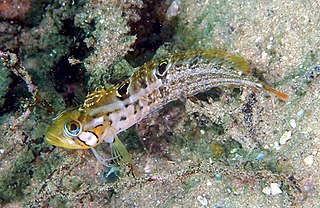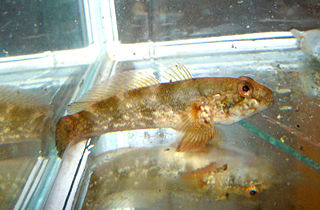
The sand goby, also known as a polewig or pollybait, is a species of ray-finned fish native to marine and brackish European waters from the Baltic Sea through the Mediterranean Sea and into the Black Sea where it occurs in sandy or muddy areas of inshore waters at depths of from 4 to 200 metres. This species can reach a length of 11 centimetres (4.3 in) TL. This species is sometimes kept in public aquariums. The sand goby is of a sandy colour, with darker markings on the sides and a creamy-white underside. In the breeding season the male fish has blue spot at the rear of the first dorsal fin, ringed with white. The fish has a slender body, and the head is about a quarter of the total length.

The whitemargin unicornfish, also known as the ringtailed unicornfish or short-horned unicorn-fish, is a tropical fish found throughout the Indo-Pacific. It can reach a length of 100 cm, making it one of the largest members of the family Acanthuridae.

The black goby is a species of ray-finned fish found in the Eastern Atlantic and Mediterranean Sea and Black Sea. It inhabits estuaries, lagoons, and inshore water over seagrass and algae. It feeds on a variety of invertebrates and sometimes small fish. This species can also be found in the aquarium trade.

The monkey goby is a species of goby native to the basins of the Black Sea and the Sea of Azov.

Ponticola kessleri, the bighead goby or Kessler's goby, is a species of goby native to Eurasia. The bighead goby is a Ponto-Caspian relict species. It inhabits the fresh and oligohaline waters, with mineralisation from 0-0.5‰ up to 1.5-3.0‰.

The Syrman goby is a species of goby native to marine, brackish and probably fresh waters of the Black Sea, the Sea of Azov and the Caspian Sea basins. They inhabit inshore waters with substrates composed of shell fragments, sand, mud or muddy sand. This species can reach a length of 24.5 centimetres (9.6 in) TL.

Naso brevirostris, also known as the short-nosed unicornfish, spotted unicornfish, brown unicornfish, lined unicornfish, longnose surgeonfish, palefin unicornfish, paletail unicornfish, shorthorned unicornfish or shortsnouted unicornfish, is a species of marine ray-finned fish belonging to the family Acanthuridae, the surgeonfishes, unicornfishes and tangs. It occurs in the Indian and western Pacific Oceans.

Cirrhibarbis capensis, the barbelled klipfish, is a species of clinid found in subtropical waters of the Atlantic Ocean around South Africa. This species can reach a maximum length of 36 centimetres (14 in) TL. This species preys primarily on benthic crustaceans, mostly amphipods and isopods. It is currently the only known member of its genus.

The western tubenose goby is a species of goby native to fresh waters of the Black Sea and Aegean Sea basins. It has recently spread as an invasive species to Central and Western Europe and to North America. Previously Proterorhinus semilunaris was considered as a junior synonym of Proterorhinus marmoratus, but was confirmed as a distinct species based on molecular analysis.

Ponticola is a genus of gobies native mostly to fresh waters of the Black Sea - Caspian Sea region in Eurasia. Some species occur in the brackish-water Black and Caspian seas themselves. It was considered to be part of the broader goby subfamily Benthophilinae, also endemic to the same region, although the 5th edition of Fishes of the World does not list any subfamilies in the Gobiidae. Originally, Ponticola was described as subgenus of Neogobius.
Blennioclinus brachycephalus, the Lace klipfish, is a species of clinid found in subtropical waters of the Atlantic Ocean around South Africa. This species can reach a maximum length of 15 centimetres (5.9 in) TL. This species primarily preys on benthic fauna including isopods, amphipods, and mollusks.
Blennophis anguillaris, the snaky klipfish, is a species of clinid found in the subtropical waters of the Atlantic Ocean around South Africa. It can be found in the subtidal zone and also is a denizen of tidepools. This species can reach a maximum length of 30 centimetres (12 in) TL.

Clinus berrisfordi, the Onrust klipfish, is a species of clinid that occurs in subtropical waters of the Atlantic Ocean from False Bay to Skoenmakerskop, South Africa where it prefers marine and brackish habitats with plentiful growth of seaweed. This species can reach a maximum length of 12 centimetres (4.7 in) TL.

Clinus venustris, the speckled klipfish, is a species of clinid that occurs in subtropical waters of the Atlantic Ocean from Namibia to South Africa where it is found in the subtidal zone as well as being a denizen of tide pools. This species can reach a maximum length of 12 centimetres (4.7 in) TL. and feeds primarily on amphipods, isopods, mysids, and echinoderms.

The grass goby is a species of goby native to the Mediterranean Sea, the Sea of Azov and the Black Sea. It is the only known member of its genus.

The flatsnout goby is a species of goby endemic to the Black Sea where it is mostly known from inshore waters amongst rocks and boulders. It is occasionally found offshore over areas with gravel substrates. This species can reach a length of 22.5 centimetres (8.9 in) TL.

The ratan goby is a species of goby native to brackish and marine waters of the Black Sea, the Sea of Azov and the Caspian Sea. In the Caspian Sea it is presented by subspecies Ponticola ratan goebeli. It occurs in inshore waters, inhabiting areas with stone or gravel substrates. This species can reach a length of 20 centimetres (7.9 in) TL.

The chameleon goby is a species of ray-finned fish native to marine and brackish waters along the coasts of eastern Asia. It has also spread to other parts of the world where it is found in waters with varying degrees of salinity.

Valenciennea helsdingenii is a species of goby from the Indo-Pacific. It is commonly known as the twostripe goby, black-lined sleeper goby, or railway sleeper goby. It can grow up to a length of 25 cm (9.8 in) and is distinguishable by two prominent orange to black lines running longitudinally through its body.

Diplecogaster bimaculata, the two-spotted clingfish, is a species of fish in the family Gobiesocidae found in Black Sea, Mediterranean Sea and Atlantic Ocean where it is found on rocks and among seagrass or shell beds.



















